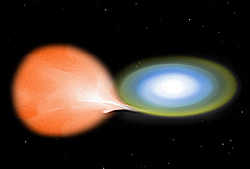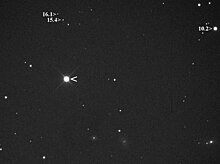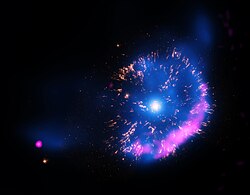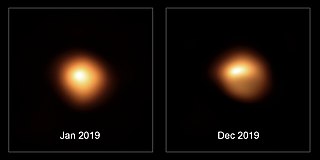
A variable star is a star whose brightness as seen from Earth changes with time. This variation may be caused by a change in emitted light or by something partly blocking the light, so variable stars are classified as either:

In astronomy, cataclysmic variable stars (CVs) are stars which irregularly increase in brightness by a large factor, then drop back down to a quiescent state. They were initially called novae, since ones with an outburst brightness visible to the naked eye and an invisible quiescent brightness appeared as new stars in the sky.

T Pyxidis is a recurrent nova and nova remnant in the constellation Pyxis. It is a binary star system and its distance is estimated at 4,783 parsecs from Earth. It contains a Sun-like star and a white dwarf. Because of their close proximity and the larger mass of the white dwarf, the latter draws matter from the larger, less massive star. The influx of matter on the white dwarf's surface causes periodic thermonuclear explosions to occur.

V1974 Cygni or Nova Cygni 1992 was a nova, visible to the naked eye, in the constellation Cygnus. It was discovered visually with 10×50 binoculars on February 19, 1992, by Peter Collins, an amateur astronomer living in Boulder, Colorado. At that time he first noticed it, it had an apparent magnitude of 7.2. Nine hours later he saw it again, and it had brightened by a full magnitude. For this discovery Collins was awarded the AAVSO Nova Award in 1993. The nova reached magnitude 4.4 at 22:00 UT on 22 February 1992. Images from the Palomar Sky Survey taken before the nova event showed identified a possible precursor which had photographic magnitudes of 18 and 17, but the identification of the precursor is not firm.
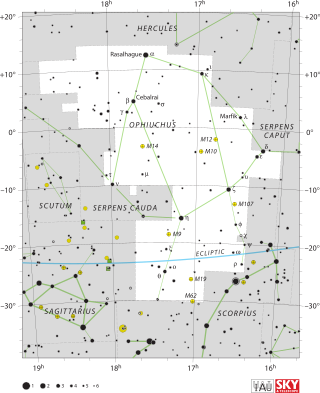
RS Ophiuchi is a recurrent nova system approximately 5,000 light-years away in the constellation Ophiuchus. In its quiet phase it has an apparent magnitude of about 12.5. It has been observed to erupt in 1898, 1933, 1958, 1967, 1985, 2006 and 2021 and reached about magnitude 5 on average. A further two eruptions, in 1907 and 1945, have been inferred from archival data. The recurrent nova is produced by a white dwarf star and a red giant in a binary system. About every 15 years, enough material from the red giant builds up on the surface of the white dwarf to produce a thermonuclear explosion. The white dwarf orbits close to the red giant, with an accretion disc concentrating the overflowing atmosphere of the red giant onto the white dwarf.

HR Lyrae or Nova Lyrae 1919 was a nova which occurred in the constellation Lyra in 1919. Its discovery was announced by Johanna C. Mackie on 6 December 1919. She discovered it while examining photographic plates taken at the Harvard College Observatory. The bulletin announcing the discovery states "Between December 4 and 6 it rose rapidly from the sixteenth magnitude or fainter, to a maximum of about 6.5". It was the first nova ever reported in Lyra, and Mackie was awarded the AAVSO gold medal for her discovery. Its peak magnitude of 6.5 implies that it might have been visible to the naked eye, under ideal conditions.
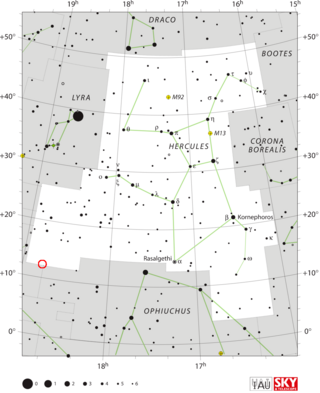
V838 Herculis, also known as Nova Herculis 1991, was a nova which occurred in the constellation Hercules in 1991. It was discovered by George Alcock of Yaxley, Cambridgeshire, England at 4:35 UT on the morning of 25 March 1991. He found it with 10×50 binoculars, and on that morning its apparent visual magnitude was 5. Palomar Sky Survey plates showed that before the outburst, the star was at photographic magnitude 20.6 and 18.25.
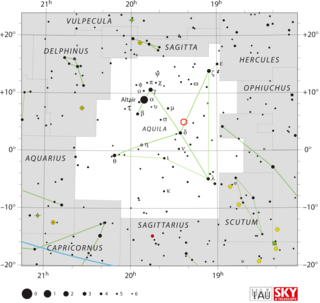
V1494 Aquilae or Nova Aquilae 1999 b was a nova which occurred during 1999 in the constellation Aquila and reached a brightness of magnitude 3.9 on 2 December 1999. making it easily visible to the naked eye. The nova was discovered with 14×100 binoculars by Alfredo Pereira of Cabo da Roca, Portugal at 18:50 UT on 1 December 1999, when it had a visual magnitude of 6.0.
An AM Canum Venaticorum star, is a rare type of cataclysmic variable star named after their type star, AM Canum Venaticorum. In these hot blue binary variables, a white dwarf accretes hydrogen-poor matter from a compact companion star.
A helium star is a class O or B star (blue), which has extraordinarily strong helium lines and weaker than normal hydrogen lines, indicating strong stellar winds and a mass loss of the outer envelope. Extreme helium stars (EHe) entirely lack hydrogen in their spectra. Pure helium stars lie on or near a helium main sequence, analogous to the main sequence formed by the more common hydrogen stars.
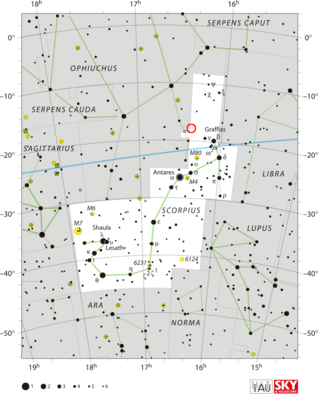
U Scorpii is a recurrent nova system; one of 10 known recurring novae in the Milky Way galaxy. Located near the northern edge of the constellation Scorpius it normally has a magnitude of 18, but reaches a magnitude of about 8 during outbursts. Outbursts have been observed in 1863, 1906, 1936, 1979, 1987, 1999, 2010, and 2022.

V445 Puppis was a nova in the constellation Puppis. It was discovered by Kazuyoshi Kanatsu of Matsue, Shimane, Japan, who recorded a peak magnitude of on December 18, 2000. The nova was reported by Taichi Kato of Kyoto University in the International Astronomical Union circular 7552, issued on December 30, 2000. The location of this nova coincided with a magnitude 13.1 star that had been photographed in 1967. The proper motion of this star was measured as -4.7 mas/yr in right ascension and +6.4 mas/yr in declination, with a standard error of 4 mas/yr.

KT Eridani was a bright nova in the constellation Eridanus that produced an outburst in 2009. It was the first classical nova ever detected in that constellation. The nova was discovered at 12:52 UT on 25 November 2009 by K. Itagaki at Yamagata, Japan with a 21 cm patrol telescope. At the time of its discovery, it was a magnitude 8.1 object. The discovery occurred after the nova's peak brightness, but the All Sky Automated Survey system had detected the nova on three earlier occasions, allowing a more complete light curve to be produced. The peak magnitude, 5.4, was seen at 15:10 UT on 14 November 2009.

RW Ursae Minoris is a cataclysmic variable star system that flared up as a nova in the constellation Ursa Minor in 1956.

IM Normae is a recurrent nova in the constellation Norma, one of only ten known in the Milky Way. It has been observed to erupt in 1920 and 2002, reaching magnitude 8.5 from a baseline of 18.3. It was poorly monitored after the first eruption, so it is possible that it erupted in between these dates.

V392 Persei, also known as Nova Persei 2018, is a bright nova in the constellation Perseus discovered on April 29, 2018. It was previously known as a dwarf nova.
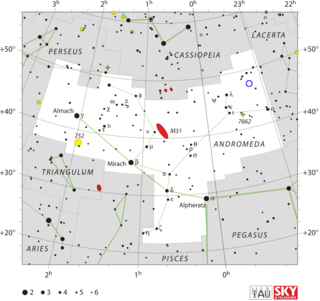
OS Andromedae, known also as Nova Andromedae 1986, is a classical nova that appeared in the constellation Andromeda during 1986. It was discovered at 10:34 UT on 5 December 1986 by Mitsuri Suzuki, a 28-year-old school teacher living in Ena, Japan. He photographed the portion of the Milky Way that passes through northern Andromeda with a 200-mm telephoto lens, and found the nova when its apparent magnitude was 8.0. Two days later it reached a peak apparent visual magnitude of 6.3.
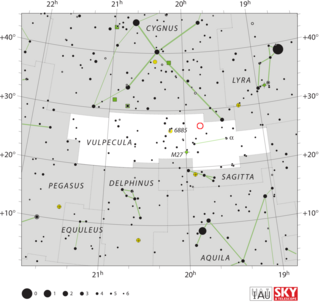
LV Vulpeculae, also known as Nova Vulpeculae 1968 no. 1, was the first of two novae in the constellation of Vulpecula which erupted in 1968. It was discovered by George Alcock who observed it from the back garden of his home in Farcet, England, on the morning of 15 April 1968. The next night it was independently discovered by Midtskoven in Norway. It reached a peak apparent magnitude of 4.79 on 17 April 1968. It was visible to the naked eye at the same time HR Delphini was a naked eye object, and the two novae were less than 15 degrees apart on the sky.

V1370 Aquilae, also known as Nova Aquilae 1982, is a nova that appeared in the constellation Aquila during 1982. It was discovered by Minoru Honda of Kurashiki, Japan at 20:30 UT on 27 January 1982. At that time the Sun had moved just far enough from Aquila to allow the nova to be seen in the morning sky. Although it was discovered photographically, its apparent magnitude was 6–7, making it potentially visible to the naked eye under ideal conditions. A possible magnitude 20 progenitor was located on the Palomar Sky Survey prints. Spectra of the object were taken in February 1982 at Asiago Astrophysical Observatory, which confirmed that it is a nova.
